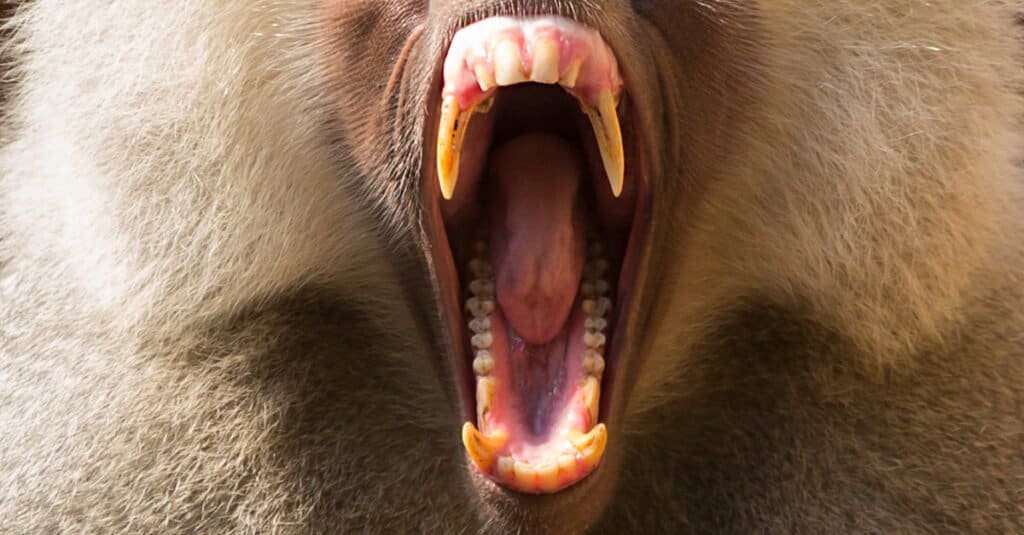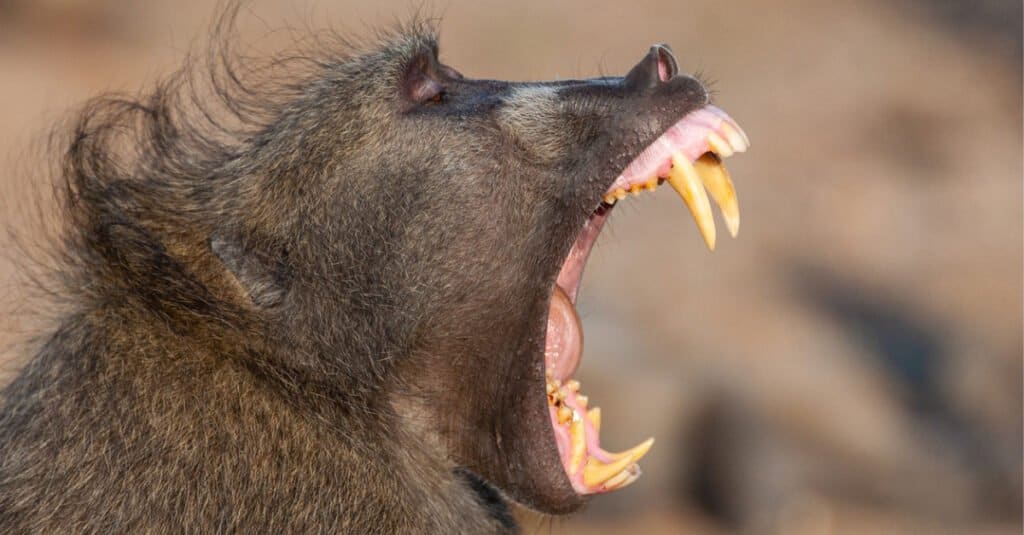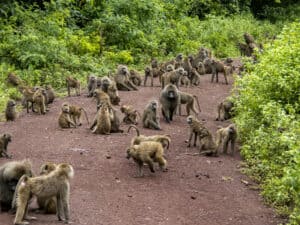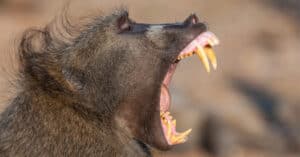The baboon is one of the largest primates on the planet that belong to the Old World Monkeys group. Male baboons weigh between 31 to 88 pounds on average. They measure from 20 to 40 inches long, excluding their short tails that all vary in length. There are five different species: the Chacma Baboon, the Guinea Baboon, the Yellow Baboon, the Olive Baboon, and the Hamadryas Baboon. All species inhabit different parts of Africa and Western Arabia, settling mainly along grasslands, rainforests, and rocky deserts. Baboons generally prefer to settle in savannas but some groups also live in tropical forests.
Most types of monkeys have gripping tails that help them climb trees. Their tails also enable them to grab on twigs and branches to swiftly leap from one tree to another. Baboons, however, do not have this kind of prehensile tail. Despite the lack of it, baboons still climb trees in order to sleep, feed, or keep an eye out for trouble.
Baboons are opportunistic feeders, which means they can adapt to eating any food that is available to them. A baboon’s diet consists mostly of insects, fruits, seeds, and grasses. However, as omnivores, they also eat animal meat such as those of rodents, birds, sheep, and even young antelope. This suggests that baboons must have a sharp set of teeth to be able to puncture, kill, and devour their prey.
How Many Teeth Do Baboons Have?

Like humans, baboons have 32 teeth.
©iStock.com/sneil375
Just like humans and other Old World monkeys and apes, baboons have 32 teeth. The usual dental formula of a baboon’s teeth or jaw structure is as follows: Incisors 2/2; Canines 1/1; Premolars 2/2; Molars 3/3 = 32. The number of teeth in the top and bottom, represented as top/bottom, of one side of the jaws is expressed by the equation.
This formula differs from those of the New World monkeys though, as they typically have much fewer teeth because of the absence of some premolars in the upper and lower parts of their jaw.
Dentition is a structural adaptation to a particular diet. It is closely tied to the feeding and hunting behavior of any given animal species. Given that baboons mainly feed on both plants and other animals, it is not surprising that baboon teeth are closely similar to other carnivores with canine teeth and sharp, flesh-breaking molars.
All primates (including humans), and indeed all mammals in general, have a dentition that is composed of a variety of distinct types of teeth, including canines, incisors, and cheek teeth. This trait that is innate to most primates is called heterodonty.
How Big Are Baboon Teeth?

Baboons canines may grow up to two inches long.
©iStock.com/RudiHulshof
Baboons might not be the first animals that come to mind when thinking about large-toothed animals. But in reality, their canines may actually grow up to two inches long. These canine teeth are maximized in fights with rival males during the mating season, much like the saber-toothed deer’s fangs are.
A 2015 study on the relationship between a baboon’s canine length to its dominance rank has suggested that the length of a baboon’s canine teeth can have an influence on male baboons’ dominance. It states thoroughly that male baboons who possess higher ranks of dominance also have longer sets of canine teeth for their ages, in comparison to those who have shorter canines.
For every heterodont animal, regardless of species, canines are a fundamental component of dentition. Therefore, tooth size may have substantial implications for fighting skill. Hence, for social dominance rank, reproductive success, and fitness in general.
Why Do Baboons Have Sharp, Pointed Teeth?
Baboons are not adept hunters like most meat-eaters. However, baboons have sharp teeth that are long enough to scare off other monkeys seeking dominance.
Baboons do not just feed on animal meat, they are also plant-eaters. They even steal crops, causing major problems for farmers. But despite being omnivores, baboons usually munch on roots and nuts that might require them to have tough teeth that can grind both plant material and animal flesh. Baboons’ sharp canines are also used to display their dominance over a territory, defending and competing against other male baboons.
As soon as they are fully erupted and have grown to their maximum length, baboons’ top canines are constantly worn down against their lower canines and first premolar teeth. This type of functional deterioration or honing develops wear facets which helps to keep the canine tip and edge sharp.
What Do Baboons Eat?

As omnivores, baboons eat plants and smaller mammals like rodents, sheep, and young antelopes.
©iStock.com/andyjkramer
With their powerful canine teeth, baboons are capable of killing small mammals in an instant with a single bite. As omnivores, baboons eat both plants and animals. Thus, they would need pointed canine teeth like those of most carnivores in order to kill their prey easily.
Baboons are crop pirates, and their food consists primarily of plants, seeds, nuts, and roots, as well as smaller mammals like sheep, rodents, and even young antelopes. Moreover, baboons are also capable of adjusting to a situation in which there are sufficient food and water supplies. Baboons are opportunistic eaters who, because of their preference for crops, have become a destructive problem for many African farmers.
Can Baboons Bite Humans?
Baboons have not been known to attack people, even though humans have been the primary cause of reducing baboon populations. There’s no question that baboons, with their massive canine teeth, can be quite intimidating. However, a typical adult person, is twice the size of a baboon, making him far stronger than this animal.
The photo featured at the top of this post is © iStock.com/Skouatroulio
Thank you for reading! Have some feedback for us? Contact the AZ Animals editorial team.





